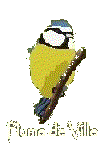Plume de Ville
Form day to day.
°°°°°°°°°°°°°°°°°°°°°°°° °
October 2007
8 October
Canada geese at bath.
One dives.
And hop, I
turn! In the end, you judder well.
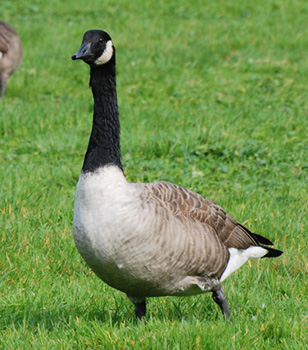
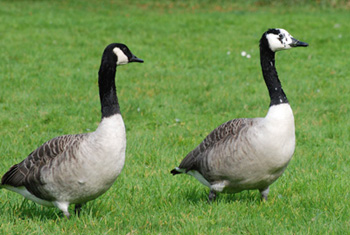
Distinctive
feature: black neck and white "chinstrap".
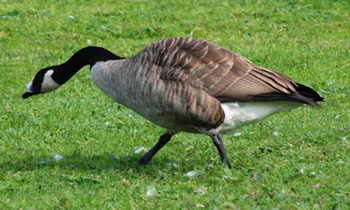
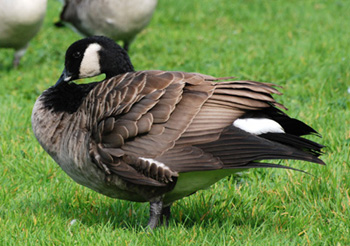
Give way, I
come.
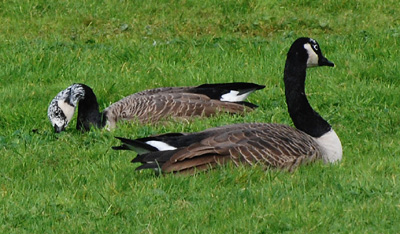
Probably some
are at the end of moulting an exhibit a curious plumage. Partially white head
and eyes ringed white.
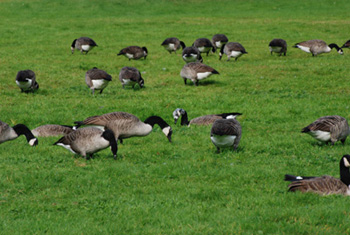
[Branta canadensis. Canada goose.]
Originally
from North America they where introduced in Europe (as soon as the 17th
century in the
About one
hundred Canada geese together.
Parc de Chamarande (Essonne-France)
10 October
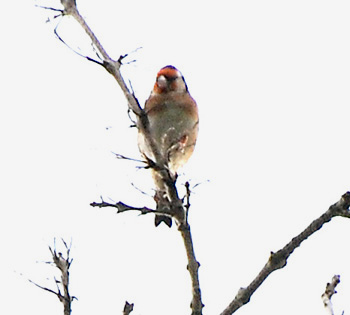
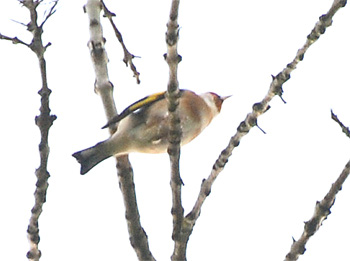
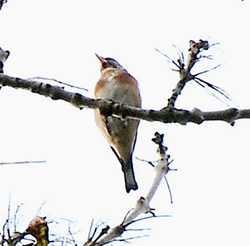
European goldfinch.
[Carduelis carduelis. Passerifomes. Fingilidea.]
The red mask of his face is typical, as well as the yellow of the edge of its
wings. The species is protected.
Parc de Chamarande (Essonne) 8 October 2007
In the same
park as that of geese, two "goldfinch trees".
At the beginning of August they gather seeking the proximity to a water pond where
they like to bath.
Two gangs of a score of birds chirp in chorus, perched high (they like to be at
the extremity of branches) in the trees. They were quite difficult to
photograph (too far) and the picture quality suffers. Granivorous, it feeds on seeds
of herbaceous plants, seeds birch. As its name indicates, its beak is sharp
enough to go dislodge the seeds of burdock and thistles that he loves.
It is a partly migratory bird.
de la coccinelle
16 October
The balcony
is gradually taking its fall aspect. The orchids, having spent the summer
outside, already show their flower stalks and have returned to the home warmth.
The paphiopedilums and cymbidiums benefit still for some days of the freshness
of nights.
I removed
the impatiens which reach
Magnificent
sunshine this morning, as yesterday, without fog. The couple of small blues is
on visit and shows keen interest in the nest box. She passes the head through
the entrance and she starts pecking the edge of the entrance hole. Already? No
photo, I did not want to intrude too closely. Silent during the summer, they start
to sing perched on birch.
The couple of
great tits passes every day since the sunflower seeds are supplied. She enters without
difficulty, but he has some difficulties to pass the belly.
Oops!
Definitely, it will be necessary for me to do a little diet.
Usually blackbirds
come to eat the berries from the vine a little later in the season, this year the
sparrows pre-empted them and have already begun. This is the first time I see
them eat the grapes.
The blackbirds regroup, six of them in the bottom garden.
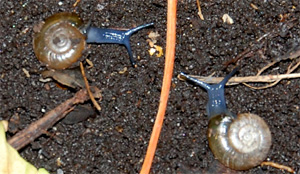
Fall cleaning
has disturbed these newcomers to the balcony, hidden under a pot.
It is probably one Oxychilus, earth gastropod, zonitidae family ( "glass
snails"), a wetlands snail. It has a dark blue body and a flat shell,
translucent, fine, and brilliant, a little clearer in the underside, of 10mm, 4
whorls (but this should depend on the age (?)).
Some members
of the family smell... garlic. This is not the case for those ones. Some have a
vegetarian and carnivorous diet. Carnivores, they can aggress their congeners;
some are troglophiles and digest even insects.
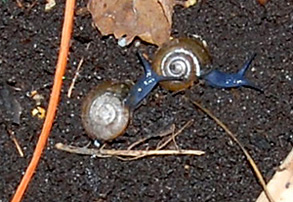
17 October
It is
colder at night; the vines blush and turn to the dark red of the anthocyanin.
This replaces the natural pigment chlorophyll and goes from red to blue, the
same that colours grapes, blueberries, cherries ...
This fall many trees have exceptional colour. The colour of the leaves depends
on the acidity (for red, which is not at the cells but in the sap of the leaf,
the more acidic is the sap the most red is the leaf, the less it is the more it
is purple), but also on the temperature (cold but not frost) and on the rain (best colour
in dry weather).
Hot days and cold nights favours these beautiful colours.
The balcony would have become
a haven for snails?
This one has the aspect of a garden snail [or Helix aspersa, Cornu aspersum]
(?). I found it hidden in a pot of orchids (no, I am not willing to breed them,
it happens sometimes that I rant against the nibbling of the flower buds, the
most tender parts in an orchid!)
The ladybugs seek a shelter for the winter.
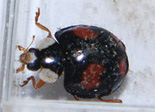 This one which sought
refuge at home is an Asian lady beetle imported from
This one which sought
refuge at home is an Asian lady beetle imported from 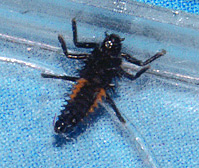 [Harmonia axyridis] and not the
"lady beetle" of the family Coccinellidae.
[Harmonia axyridis] and not the
"lady beetle" of the family Coccinellidae.
She has so well acclimatized that it has become dominant and replaces
"our" indigenous ladybugs.
For more information: the website l'Observatoire pour le suivi de la coccinelle asiatique en France of Vincent Ternois and report their presence.
And the Coccinelle asiatique of the OPIE.
22 October
Cold, very cold
the past few days,
The birch
is gold. Its catkins (strobile) will remain all winter and the tiny two winged
nuts that are the seeds (nutlets), are a delicacy for our visitors.
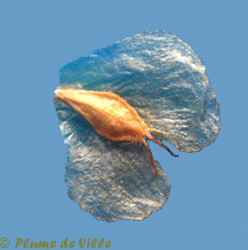
The spring bulbs are
planted. Usually I plant the bulbs in large pots, a layer of daffodils and
tulips, crocuses and grape
hyacinths, and I plant on top of them, heather and cyclamen, who
spend all winter over the bulbs. I transplant them in the spring, when the
bulbs start to sprout. Winters are less cold now and the shoots of bulbs raise the
plants placed over them too early. So, this year, I planted the bulbs alone. The winter
plants are in small pots placed over the bulb pots. As I worked on my plants,
two great tits "teet-teeted" against me. Eventually, after a few
minutes, they came and helped themselves to the sunflower seeds just beside me.
A sparrow boasts a
pretty cream necklace.
And this
young female appreciates the pear.
Sparrows
and tits are dependable but we have not seen anew any greenfinch.
The Blue Passion Flower [Passiflora caerulea] has made
several fruits, but only this one has hold and grown. It yellows slowly. Its
fruits are edible but tasteless.
25 October
Autumn bays.
With its
pulp soft, sweet and slightly acid: rose hip (also rose haw) (false) fruit of the
rose-bush and the Dog Rose. Slough of its seeds (the real fruits: achenes) and
scratching his hair (it is also called 'gratte-cul'), it is edible as jam,
syrups, liqueurs. The rosehips become soft after several frosts.
Appetizing
grapes of Japanese creeper, which are often peeked by birds. For us, they are
toxic.
[Parthenocissus tricuspidata 'Veitchii']
27 October
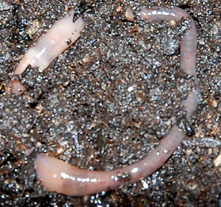
After my
second winter bulb and flower planting, the soil well mellowed with potting
soil attracted a blackbirds which scraped with good heart all the pots, unearthing
even some bulbs, projecting anywhere on earth, to find their favourite
greediness, plump earthworms. I hope he will give left me some of them, I too like
them well but to stay in the pots and aerate the soil.
Common
animals of the terrace, woodlice. They are found in the pots, pieces of wood
and sometimes at home when I take in, inadvertently in the autumn, a plant that
has spent the summer outside! But they do not like the dry home atmosphere.
They are not insects but crustaceans. They have seven pairs of legs (3 for
insects). At the back are five pairs of appendages (swimmerets or pleopods)
acting as "gills" capturing oxygen under a thin film of water in the
species of woodlice living in very humid habitats. Some, more sophisticated and
better adapted to terrestrial life, have gills with a kind of "lungs"
(pseudo-trachea) that receives oxygen directly from the air. Water is an
essential element for woodlice.
The woodlice feed only on decomposing material, they are detritivore (detritus
feeders) and I leave them willingly, as for earthworms, live their life in my
pots. The eggs hatch in a moist pocket (marsupium). Youngsters have then 6
pairs of legs, they will have their seventh in the first moult.
Those that
we have here seem to be "Porcellio scaber", or rough woolouse of 1 to
Common rough woodlouse or simply rough woodlouse.
[Class Crustaceans, spur arthropod, class of Malacostraca, order of Isopoda,
suborder Oniscidea]
